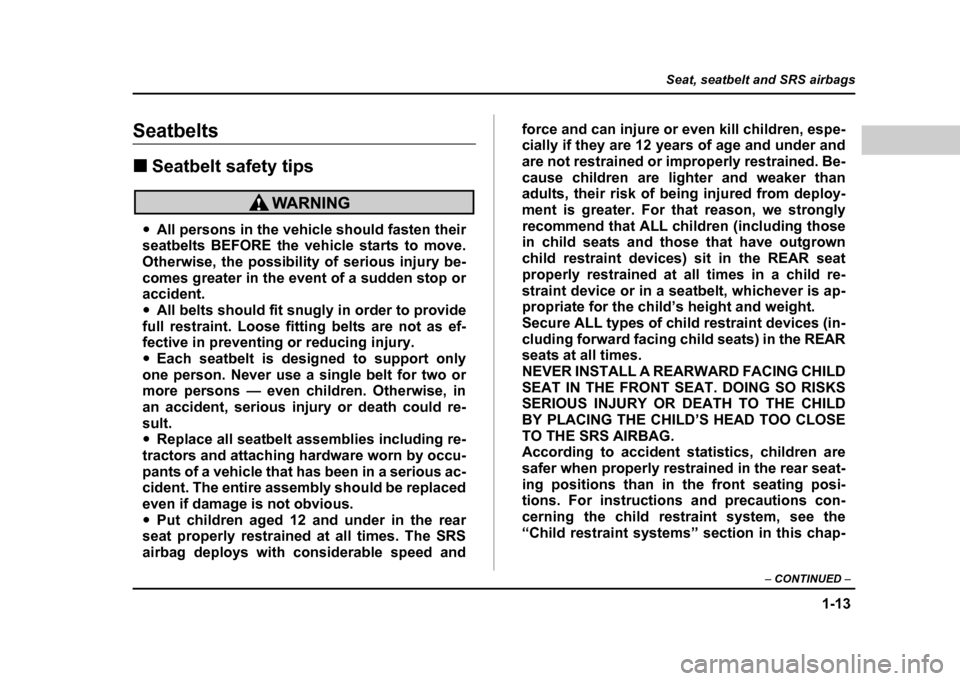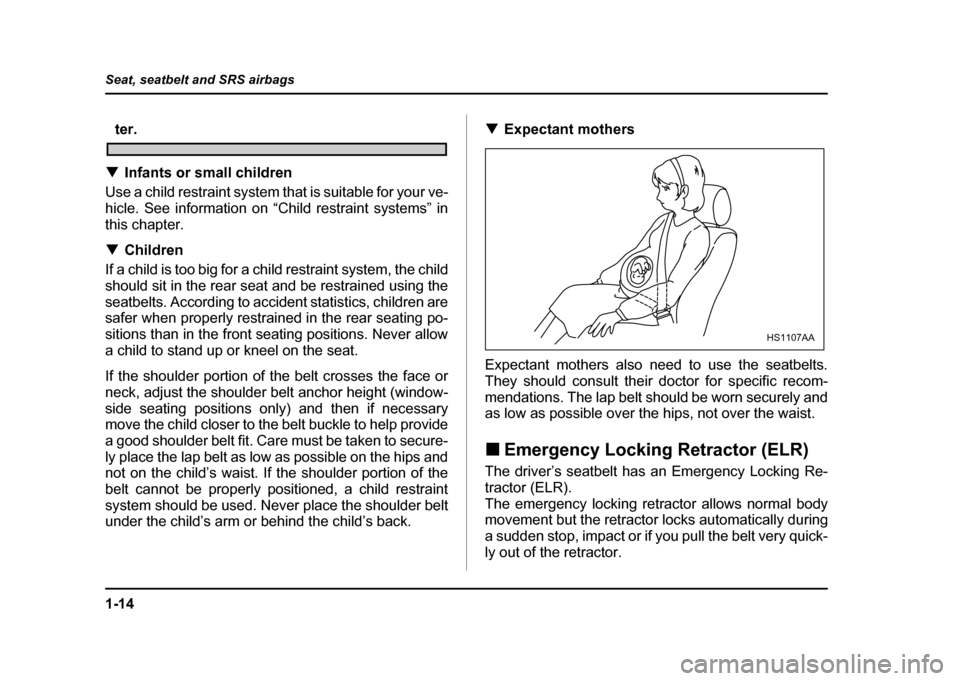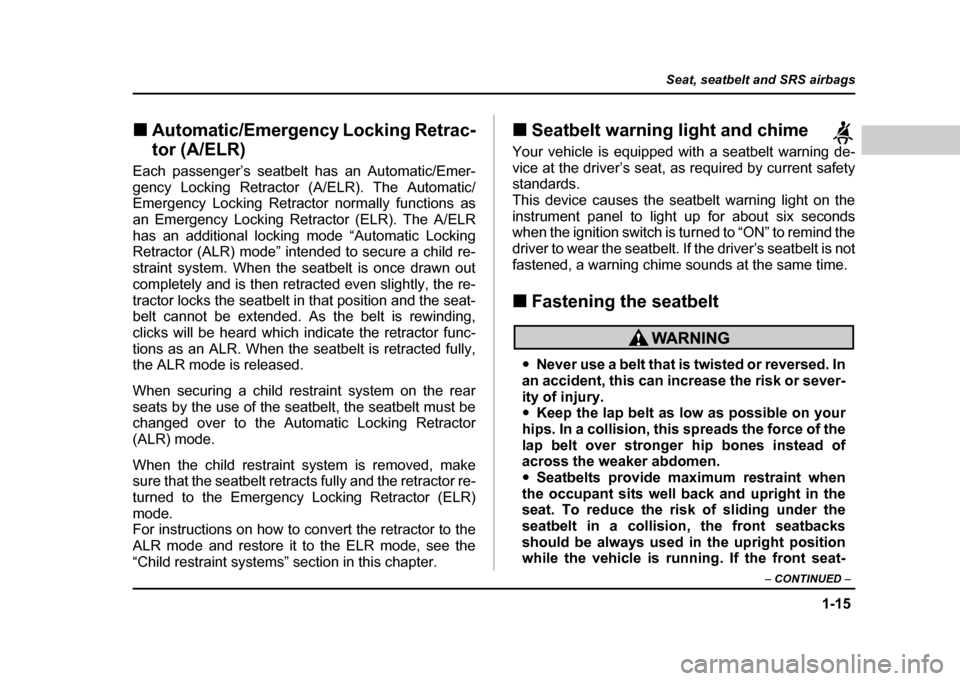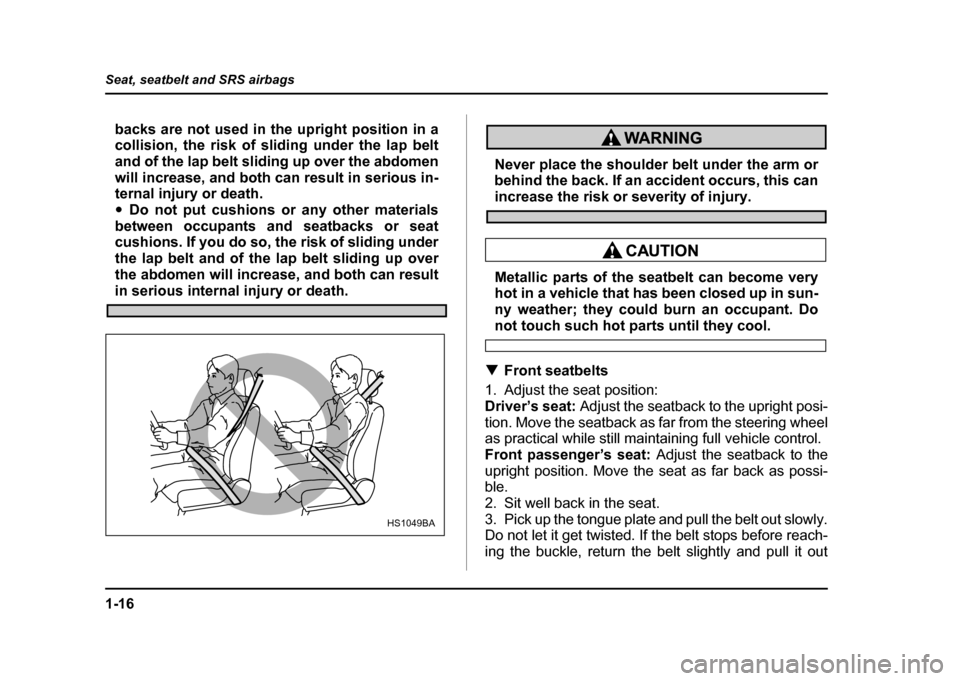Page 36 of 491
1-9
Seat, seatbelt and SRS airbags
– CONTINUED –
Never stack luggage or other cargo higher than
the top of the seatback because it could tumble
forward and injure passengers in the event of a
sudden stop or accident. !
Armrest (if equipped)
To lower the armrest, pull on the top edge of the arm- rest.
To avoid the possibility of serious injury, pas-
sengers must never be allowed to sit on the
center armrest while the vehicle is in motion.
HS8005BA
UG1504BA
Page 37 of 491
1-10
Seat, seatbelt and SRS airbags
!
Loading long objects
Folding down the armrest and opening the seatback
panel affords a loading space for long objects.
To open the seatback panel, pull the release tab.
" Secure long objects properly to prevent them
from shooting forward and causing serious in-
jury during a sudden stop or sharp cornering.
Tie long objects down with a rope or something
equivalent. " Avoid loading objects longer than 6.6 ft (2 m)
and heavier than 55 lb (25 kg). Such objects can interfere with the driver’s proper operation of
the car, possibly causing an accident and seri-
ous injury.
UG1505BA
UG1506BA
Page 38 of 491
1-11
Seat, seatbelt and SRS airbags
– CONTINUED –
!Headrest adjustment – Wagon
To raise the headrest, pull it up.
To lower it, push the head rest down while depressing
the release button on the top of the seatback.
When the seats are not occupied, lower the headrests
to improve rearward visibility. !
Rear center seating position
To raise the head restraint, pull it up.
To lower it, push the headrest down while pressing the
release button on the top of the seatback.
When the rear-center seating position is occupied,
place the headrest in its highest position. When the
rear center seating position is not occupied, lower the
headrest to improve rearward visibility.
HS1046BAHS1106BA
Page 39 of 491
1-12
Seat, seatbelt and SRS airbags
!
Folding down the rear seat – Wagon 1. Lower the headrests.
2. Unlock the seatback by pulling the release knob
and then fold the seatback down.
To return the seatback to its original position, raise the
seatback until it locks into place and make sure that it
is securely locked.
"
After returning the rear seat to its original po-
sition, be certain to place all of the seatbelts and the tab attached to the seat cushion above
the seat cushion. And make certain that the
shoulder belts are fully visible. " Never allow passengers to ride on the folded
rear seatback or in the cargo area. Doing so
may result in serious injury or death. " Secure lengthy items properly to prevent
them from shooting forward and causing seri-
ous injury during a sudden stop.
HS1047BA
HS1048BA
Page 40 of 491

1-13
Seat, seatbelt and SRS airbags
– CONTINUED –
Seatbelts !Seatbelt safety tips
"All persons in the vehicle should fasten their
seatbelts BEFORE the vehicle starts to move.
Otherwise, the possibility of serious injury be-
comes greater in the event of a sudden stop or
accident. " All belts should fit snugly in order to provide
full restraint. Loose fitting belts are not as ef-
fective in preventing or reducing injury. " Each seatbelt is designed to support only
one person. Never use a single belt for two or
more persons — even children. Otherwise, in
an accident, serious injury or death could re-
sult. " Replace all seatbelt assemblies including re-
tractors and attaching hardware worn by occu-
pants of a vehicle that has been in a serious ac-
cident. The entire assembly should be replaced
even if damage is not obvious." Put children aged 12 and under in the rear
seat properly restrained at all times. The SRS
airbag deploys with considerable speed and force and can injure or even kill children, espe-
cially if they are 12 years of age and under and
are not restrained or improperly restrained. Be-
cause children are lighter and weaker than
adults, their risk of being injured from deploy-
ment is greater. For that reason, we strongly
recommend that ALL children (including those
in child seats and those that have outgrown
child restraint devices) sit in the REAR seat
properly restrained at all times in a child re-
straint device or in a seatbelt, whichever is ap-
propriate for the child’s height and weight.
Secure ALL types of child restraint devices (in-
cluding forward facing child seats) in the REAR
seats at all times.
NEVER INSTALL A REARWARD FACING CHILD
SEAT IN THE FRONT SEAT. DOING SO RISKS SERIOUS INJURY OR DEATH TO THE CHILD
BY PLACING THE CHILD’S HEAD TOO CLOSE
TO THE SRS AIRBAG.
According to accident statistics, children are
safer when properly restrained in the rear seat-
ing positions than in the front seating posi-
tions. For instructions and precautions con-
cerning the child restraint system, see the
“Child restraint systems” section in this chap-
Page 41 of 491

1-14
Seat, seatbelt and SRS airbags
ter.
! Infants or small children
Use a child restraint system that is suitable for your ve-
hicle. See information on “Child restraint systems” in this chapter. ! Children
If a child is too big for a child restraint system, the child
should sit in the rear seat and be restrained using the
seatbelts. According to accident statistics, children are
safer when properly restrained in the rear seating po-
sitions than in the front seating positions. Never allow
a child to stand up or kneel on the seat.
If the shoulder portion of the belt crosses the face or
neck, adjust the shoulder belt anchor height (window-
side seating positions only) and then if necessary
move the child closer to the belt buckle to help provide
a good shoulder belt fit. Care must be taken to secure-
ly place the lap belt as low as possible on the hips and
not on the child’s waist. If the shoulder portion of the
belt cannot be properly positioned, a child restraint
system should be used. Never place the shoulder belt
under the child’s arm or behind the child’s back. !
Expectant mothers
Expectant mothers also need to use the seatbelts.
They should consult their doctor for specific recom-
mendations. The lap belt should be worn securely and
as low as possible over the hips, not over the waist. ! Emergency Locking Retractor (ELR)
The driver’s seatbelt has an Emergency Locking Re-
tractor (ELR).
The emergency locking retractor allows normal body
movement but the retractor locks automatically during
a sudden stop, impact or if you pull the belt very quick-
ly out of the retractor.
HS1107AA
Page 42 of 491

1-15
Seat, seatbelt and SRS airbags
– CONTINUED –
!Automatic/Emergency Locking Retrac- tor (A/ELR)
Each passenger’s seatbelt has an Automatic/Emer-
gency Locking Retractor (A/ELR). The Automatic/
Emergency Locking Retractor normally functions as
an Emergency Locking Retractor (ELR). The A/ELR
has an additional locking mode “Automatic Locking
Retractor (ALR) mode” intended to secure a child re-
straint system. When the seatbelt is once drawn out
completely and is then retracted even slightly, the re-
tractor locks the seatbelt in that position and the seat-
belt cannot be extended. As the belt is rewinding,
clicks will be heard which indicate the retractor func-
tions as an ALR. When the seatbelt is retracted fully,
the ALR mode is released.
When securing a child restraint system on the rear
seats by the use of the seatbelt, the seatbelt must be
changed over to the Automatic Locking Retractor (ALR) mode.
When the child restraint system is removed, make
sure that the seatbelt retracts fully and the retractor re-
turned to the Emergency Locking Retractor (ELR)
mode.
For instructions on how to convert the retractor to the
ALR mode and restore it to the ELR mode, see the
“Child restraint systems” section in this chapter. !
Seatbelt warning light and chime
Your vehicle is equipped with a seatbelt warning de-
vice at the driver’s seat, as required by current safety
standards.
This device causes the seatbelt warning light on the
instrument panel to light up for about six seconds
when the ignition switch is turned to “ON” to remind the
driver to wear the seatbelt. If the driver’s seatbelt is not
fastened, a warning chime sounds at the same time. ! Fastening the seatbelt
"Never use a belt that is twisted or reversed. In
an accident, this can increase the risk or sever-
ity of injury. " Keep the lap belt as low as possible on your
hips. In a collision, this spreads the force of the
lap belt over stronger hip bones instead of
across the weaker abdomen. " Seatbelts provide maximum restraint when
the occupant sits well back and upright in the
seat. To reduce the risk of sliding under the
seatbelt in a collision, the front seatbacks
should be always used in the upright position
while the vehicle is running. If the front seat-
Page 43 of 491

1-16
Seat, seatbelt and SRS airbags
backs are not used in the upright position in a
collision, the risk of sliding under the lap belt
and of the lap belt sliding up over the abdomen
will increase, and both can result in serious in-
ternal injury or death. "
Do not put cushions or any other materials
between occupants and seatbacks or seat
cushions. If you do so, the risk of sliding under
the lap belt and of the lap belt sliding up over
the abdomen will increase, and both can result
in serious internal injury or death.
Never place the shoulder belt under the arm or
behind the back. If an accident occurs, this can
increase the risk or severity of injury.
Metallic parts of the seatbelt can become very
hot in a vehicle that has been closed up in sun-
ny weather; they could burn an occupant. Do
not touch such hot parts until they cool.
! Front seatbelts
1. Adjust the seat position:
Driver’s seat: Adjust the seatback to the upright posi-
tion. Move the seatback as far from the steering wheel
as practical while still maintaining full vehicle control.
Front passenger’s seat: Adjust the seatback to the
upright position. Move the seat as far back as possi-
ble.
2. Sit well back in the seat.
3. Pick up the tongue plate and pull the belt out slowly.
Do not let it get twisted. If the belt stops before reach-
ing the buckle, return the belt slightly and pull it out
HS1049BA